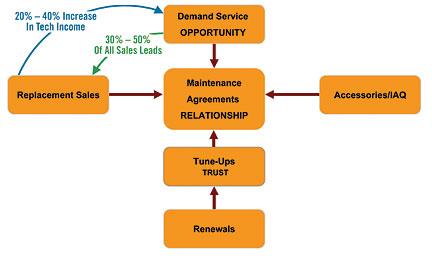Our residential replacement salesperson (or comfort advisor), Bob, thinks of himself as being honest, caring, and having a low-pressure sales style. Hank, the owner and service manager, has a good relationship with Bob, but is somewhat frustrated with the sporadic sales results.
Although Bob generates more than half the company's revenues, there is a sense that a number of leads are squandered. Bob's closing ratio is about 30 percent, and there are customers that seem to do business somewhere else when the big-ticket replacement job needs to be done.
To add to the dilemma, Bob is feeling as though he is more important to the company than his income would reflect. After all, he is generating 50 percent of the company's revenue, but a couple of technicians make almost as much as he earns. And, his company vehicle is two years older than one of the newer technician's.
There are two issues here.
Issue No. 1: Hank, being technically focused, can easily assist a technician dealing with diagnostic and repair challenges. However, Hank sees selling as the art of manipulating people's thinking, and regards it as somewhat distasteful. As a result, Bob is his own sales manager, which prevents any opportunity for success.
Issue No. 2: The technicians view Bob as pompous, a pushy salesperson, and they are somewhat un-comfortable generating leads for him. There is a sense that they need to protect customers from Bob.
What's an owner to do?
Follow The Sales Process
If you remember, we were going to build the company to the template of the residential retail business model. The parts of the model we will be focusing on will be the roles of service technician and comfort advisor, and the dependence of those roles on each other.
It is common for companies that use the business model to have 30 percent to 50 percent of all sales leads come from technician leads. But, in this case, we lack the trust of the technicians. We also have a comfort advisor that has had free reign of his days with little or no accountability.

There is a solution, though.
Let's start with establishing the premise that our company can have a specific sales process. The notion that sales is an art and can't be directed is a false presumption and actually causes unnecessary pressure, a lack of consistent results, and prevents accountability.
The process we adopt should not allow any pitching, or generate any pressure for the customer. It is a process that allows the comfort advisor to play more of a "system designer" role for the customer than a "quote giver" role.
There is a sales process that generates a closing ratio of 50 percent for marketed leads and over 85 percent for technician leads. We know from companies that have networked nationally for years that this one process generates the same results in virtually every kind of marketplace in the United States and Canada. It's known as Encouragement Sellingâ„¢.
And, no, I'm not dreaming. This does actually exist.
All Aboard
Before we implement it, though, we might ask Bob to watch this process unfold on a DVD and look at some material to get his feedback. In the past, this is something we might not be inclined to impose on Bob, but Bob needs to experience the discovery process that this Encouragement Selling method will actually contribute to his life. Only after Bob comes to the conclusion that it will work for him will we be able to successfully implement the process as policy.Ultimately, we want Bob to be the champion of this process as we build the sales department. Once this process is a company policy, we can now disclose to any future salesperson that their way of selling is to be put up on the shelf, and this is how we help people buy new systems at our company.
Bob can have a lower-pressured, more enjoyable work life, and now the technicians will have a reason to have comfort with any salesperson running their leads. More importantly, we now have an accountability tool to support Bob in his sales role. Encouragement Selling even gives us some capacity to diagnose what may be happening when Bob hears, "I want to think about it," "I need to get more bids," and "Your price is too high" too often.
And because of the nature of the selling process, we can equip Bob with methods that will close the sale with no pressure, even when the customer responds with one of these "delay" responses.
So what is this "magical" Encouragement Selling? Well, in the traditional selling model there exist three components to the process: the pitch, overcoming objections, and getting the signature (or, the close).
Often the pitch itself may create resistance. And even when we are successful, we may notice that when we look into the eyes of the new customer when they're signing the agreement, they aren't signing into a new relationship. They are signing terms of surrender because we "beat them" in the sales game.
Encouragement Selling is a process that eliminates the pitch and most of the resistance. Other effects for the customer and comfort advisor include:
Furthermore, the process is predictable and comfortable from the technician's perspective, and it offers other benefits.
Therefore, when the leadership of a company embraces the concept of "leading with process" as opposed to "managing by position" ("I'm the owner/manager"), life begins to be more enjoyable for everyone. In addition, we now can begin to escape the slavery of self-employment and begin building a business.
Next month: Biff, the salesperson, can't overcome, "I want to think about it."
Mondul is coach/member with ISL. He can be reached at nita.brooks@islinc.tv.
Publication date: 11/22/2004

Report Abusive Comment